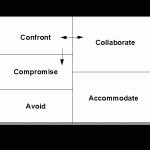by Daniel Robin
Ever notice that with some people you can sit and rationally discuss how differently you see things, and nobody gets hurt? It might even be fun! Yet, with others, particularly those closest to us, the small stuff quickly becomes big stuff. What makes the difference?
When you think back on the successful disagreements you’ve had in your life (you know, the ones that ended without loss of hair or dignity, or that actually led to a creative solution), what do they have in common?
Because conflict is such a “growth industry,” healthy workplace relationships are as essential as they are unusual. To compensate, this article will highlight tools to help us decide when to dive in and when to observe, detach, or carefully step around the “hornet’s nest.”
Setting Clear Boundaries
We use our personal power to set and maintain interpersonal boundaries. Most of us have patterns of conditioning that determine our responses. For example, if someone comes at you with a sharp stick (verbally that might sound like “I told you that wouldn’t work, and look what you did!”), is that a good time to engage? Depends on how you engage.
Conversational Aikido suggests that rather than taking an adversarial or defensive stance, rather than picking up a sharp stick of your own and preparing for counter-attack, you can move with the attacker’s energy. “So you told me what wouldn’t work? …” and “Somehow, that got you a result you didn’t want?” If this apparent plot to make you wrong continues, asking “What upset you most about it?” will give them nothing to push against.
However, if that person’s pointed attack hooks you into retaliation, you may want to use your personal power to protect the relationship.
Release Thy Enemy
Interpersonal differences that lead to fights are feedback about something we’re doing (or not doing). Could it be that we’ve had lots of practice in how to escalate, but not nearly as much in ways to de-escalate? It takes “two to tango,” but it only takes one person to stop being adversarial.
There are two practical ways to not engage (accommodate or avoid) and three others to engage, as shown below.
Strategies for Resolving Differences:
Strategy and Theme
Avoid — “Leave well enough alone”
Accommodate — “Kill ‘em with kindness”
Confront — “Might makes right”
Collaborate — “Two heads are better than one”
Compromise — “Split the difference”
Using the earlier example of a verbal sharp stick, you can use avoidance to disengage, as in “I’m not available for this conversation right now.” Or you could constructively accommodate by refocusing only on what they’re wanting for the future with “And what do you suggest we do differently next time?”Most of us rely on one or two of the five and would benefit from practicing use of the others. What are the situations when each is the right choice?
When Not to Engage
Avoiding is appropriate when there’s no way to win or there needs to be a cooling off period.
Accommodating involves listening and accepting without resistance, effective when the issue is less important than the relationship. Accommodation on minor issues which are important to others are gestures of goodwill and are a way to make deposits in someone’s “emotional bank account.”
Not engaging is different than resisting or being defensive. It can be a conscious, deliberate choice to not struggle, to protect the relationship, or to stop adversarial, win-lose dynamics. Rather than “meeting them at their own game,” call the game over and arrange to play another day in some other way.
When to Engage
On the other hand, do you sometimes have trouble taking a firm stand, even when you see the need? That could a sign that you rely too heavily on avoiding or accommodating.
Gently confronting the other person and assert your view might sound like “I didn’t use your idea because … and how can we work it out so that you can contribute here and I still get to decide how to do my job?,” which leads to collaborating on a solution. If you find yourself often hurting other people’s feelings or stirring up hostilities, consider using the other four strategies.
Collaborating might involve working together to generate win-win alternatives to resolving the issue. If you rely too heavily on this one, you’ll spend time discussing issues in depth that do not seem to deserve it.
Compromise, used to get to quick resolution, involves bargaining and mutually giving up something to reach settlement. “If I use your idea will you stop bugging me about it?” It doesn’t really solve the core issue, but it does quickly handle part of the problem and prevents further escalation.
When you know people, and you know yourself, you’ll be able to quickly assess if you can “get there from here.” To find that balance point where boundaries are neither too rigid nor too fluid, consider varying your approach by practicing each strategy for 3-6 weeks, then they’ll be available when you need them most.
When to Negotiate Directly
Lastly, negotiation makes sense whenever you can make the other person an offer or proposal that they would find more attractive than their next-best alternative. In addition….
- When it’s up to you, when there are no better alternatives
- When the task or issue is important (if it’s not, either let it go or lead strongly)
- When you’re not so fully invested in a position that you can explore options
- When not negotiating would cost you; when you have something to gain
- When there’s been a misunderstanding; when there is no understanding or agreement
- When you’d like the satisfaction, peace of mind … from handling differences openly
- To be a model: to demonstrate what effective negotiation looks/sounds/smells/feels like.



